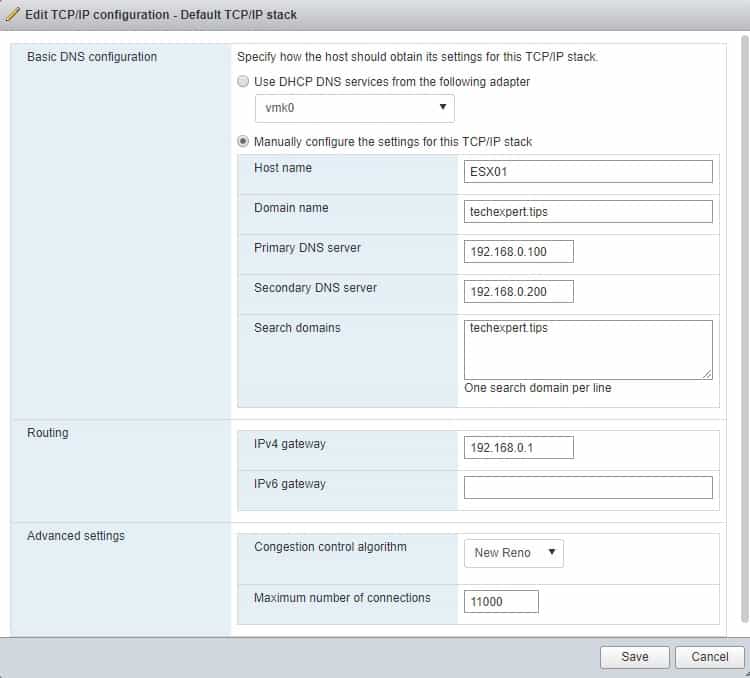

- #Setting a static ip for a vm esxi 6.5 how to#
- #Setting a static ip for a vm esxi 6.5 software#
- #Setting a static ip for a vm esxi 6.5 iso#
- #Setting a static ip for a vm esxi 6.5 free#
The IP addresses are released when the appliance is powered off. However, you can setup a Transient – IP Pool where IP addresses are automatically allocated using IP pools from a specified range when the vApp is powered on. IP Pool itself does not act as DHCP server. Update/Correction: If you create new VMs and put them on VLAN which is associated with an IP pool, those VMs will automatically get an IP address via your DHCP server. If you want the pool to leverage DHCP, check the box to let it know that a DHCP server exists. When you configure an IP Pool you specify a range of either IPv4 or IPv6 addresses, DNS and proxy settings, and select which vSwitch port groups that the pool will be available too. Usually, you'll want to do a static IP for server VMs, but you might want to have a test VLAN for developments and you need DHCP there.
#Setting a static ip for a vm esxi 6.5 software#
Virtual infrastructure monitoring software review.
Reviews – Virtualization Software and reviews, Disaster and backup recovery software reviews. Videos – VMware Virtualization Videos, VMware ESXi Videos, ESXi 4.x, ESXi 5.x tips and videos. 
#Setting a static ip for a vm esxi 6.5 free#
Free – Free virtualization utilities, ESXi Free, Monitoring and free backup utilities for ESXi and Hyper-V. VMware Workstation and other IT tutorials. #Setting a static ip for a vm esxi 6.5 how to#
How To – ESXi Tutorials, IT and virtualization tutorials, VMware ESXi 4.x, ESXi 5.x and VMware vSphere. Desktop Virtualization – Desktop Virtualization, VMware Workstation, VMware Fusion, VMware Horizon View, tips and tutorials. Backup – Virtualization Backup Solutions, VMware vSphere Backup and ESXi backup solutions. Server Virtualization – VMware ESXi, ESXi Free Hypervizor, VMware vSphere Server Virtualization, VMware Cloud and Datacenter Virtualization. Tips – VMware, Microsoft and General IT tips and definitions, What is this?, How this works?. VMware vRealize Operations and vSAN Integration Workshop. VMware vRealize Automation: Install, Configure, Manage. VMware vRealize Operations for Administrators. VMware vRealize Oprations: Install, Configure Manage. VMware Site Recovery Manager: Install, Configure, Manage. VMware Integrated Openstack: Install, Configure, Manage. VMware Cloud on AWS: Deploy and Manage 2019. VMware Workspace ONE: Advanced Integration. VMware Horizon 7: Install, Configure, Manage. VMware NSX-T Data Center: Troubleshooting and Operations. VMware NSX-T Data Center: Install, Configure, Manage. VMware vSphere: Optimize and Scale – NEW !!!. VMware vSphere: Install, Configure, Manage – NEW !!!. Test your incoming and outgoing network access and name resolution. Your VM should now properly run with the static IP address you have specified (192.168.247.40 in my case). Adjust the hostname in /etc/hostname as needed. Adjust your host definitions in /etc/hosts as needed. Edit the network interface definitions in /etc/network/interfaces and adjust them so that your entry for the primary network interface looks similar to this:. Create a backup of the file /etc/network/interfaces. Power up the VM and within the VM change the IP settings from dynamic to static IP:. NOTE: Network Adapter is set to VMnet2 now. The VM settings after adding a new interface should look like on the image below:. Only the new NAT network entry will be used for the VM. NOTE: the subnet is determined by the previous DHCP setup! Add a new network interface (VMnet2 in my case) with the following settings:. Remove or disable the existing network interfaces (VMnet0 and VMnet1 in my case you may see different names): Open the Virtual Network Editor (top menu Edit->Virtual Network Editor). Adjust the network settings using VMWare Virtual Network Editor for hosting VM with static IP:. IMPORTANT: note down this subnet information! In my case the ethernet interface was shown as 'ens33' with the DHCP setup being configured for the subnet. In the console / terminal window issue the ifconfig command to retrieve the network interface configuration. Power up the VM (if it is not running) and note the DHCP IP settings. The current configuration is displayed like this one: Once your VM is created open the VM properties. #Setting a static ip for a vm esxi 6.5 iso#
iso file of the just downloaded Ubuntu image. Create a new virtual machine(VM) using the.The version used here is: Ubuntu Server 16.04.3 LTS Please see the APIC product documentation for details. For the latter, the network configuration commands of the respective component need to be used. the IBM DataPower component and the APIC Management Server component). the Developer Portal component) are implemented on Linux, and a similar approach can be followed for the others (e.g. This procedure to configure VMWare images with static IP addresses is useful when setting up IBM API Connect (APIC) on VMWare. NOTE: VMWare Workstation 12 and Ubuntu Linux was used for this setup.






 0 kommentar(er)
0 kommentar(er)
